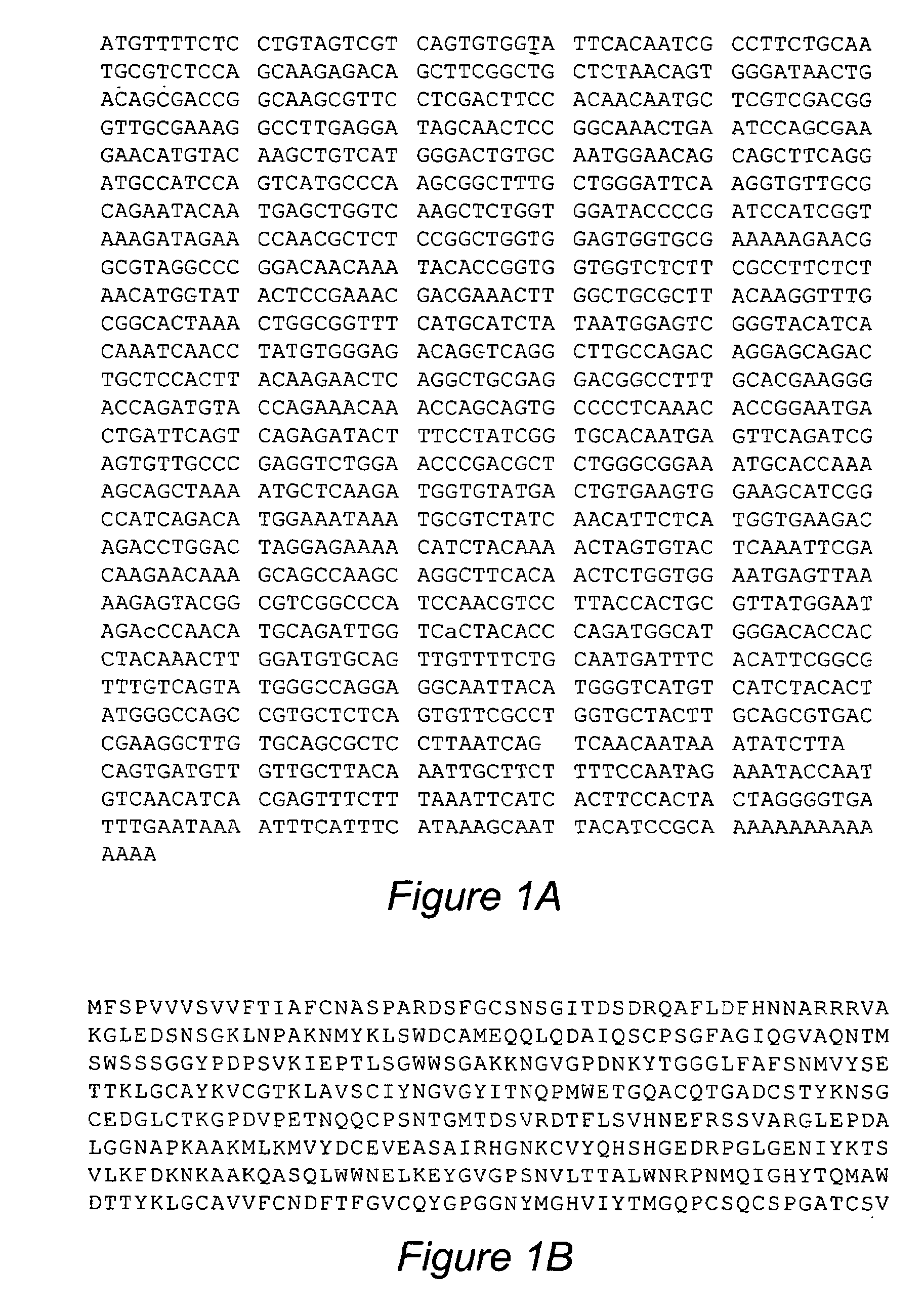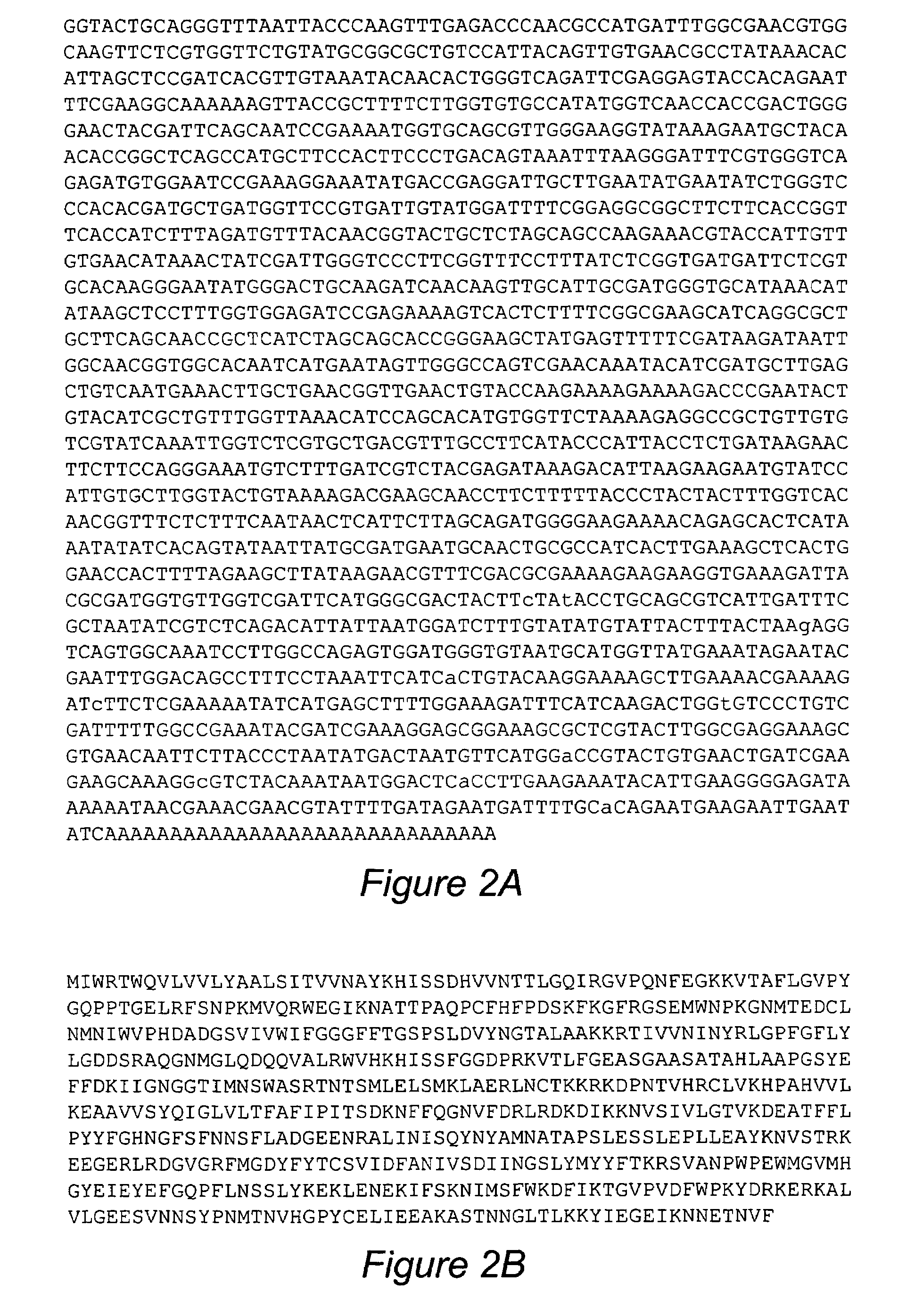Hookworm vaccine
a hookworm and vaccine technology, applied in the field of hookworm vaccines, can solve the problems of worm burden, intestinal blood loss, malnutrition, morbidity and mortality, etc., and achieve the effects of reducing the burden of worms, reducing blood loss, and reducing the size of parasitizing hookworms
- Summary
- Abstract
- Description
- Claims
- Application Information
AI Technical Summary
Benefits of technology
Problems solved by technology
Method used
Image
Examples
example 1
Results for Example 1
[0142]Ac-TMP cDNA. Ac-TMP cDNA was cloned from an adult hookworm cDNA library by immunoscreening with rabbit antibody directed against whole A. caninum adult secretory products. Two positive identical clones were isolated. The full-length cDNA consists of 559 bps (SEQ ID NO: 11) encoding an open reading frame (ORF) of 140 amino acids (SEQ ID NO: 12) and a poly-A tail at the 3′ end. The predicted ORF has a calculated molecular weight of 16,100 daltons and a theoretical pI of 7.55. There is a hydrophobic signal peptide sequence with a signal peptidase cleavage site between amino acids 16 and 17. Ac-TMP has a signature N terminal Cys-X-Cys sequence immediately following the signal peptide. One putative N linked glycosylation site (N-X-T) exists between amino acids 119 and 122 (FIG. 6B).
[0143]GenBank database searching revealed that the predicted amino acid sequence of this molecule shares 33 percent identity and 50 percent similarity to the N-terminal domain of hum...
example 2
Results for Example 2
[0159]cDNA structure of Ac-mep-1 The cloning strategy employed in obtaining the complete coding sequence of Ac-mep-1 was as follows: About 2.6 kb of the Ac-mep-1 transcript was identified by sequencing degenerate PCR clone MP-1, PCR derived clones MP-2, MP-3 and the 5′ RACE clone MP-4. Although there was a methionine codon close to the 5′ end of the RACE product, this codon was preceded by 58 in-frame amino acids that contained no stop, suggesting that MP-4 did not represent the actual 5′ end of Ac-mep-1. In addition, we have been unable to obtain a cDNA clone (by PCR) that included a spliced leader sequence. Therefore, G-MEP, a genomic DNA clone of Ac-mep-1 like sequence (98.7% exon identity), was examined with a gene prediction program for C. elegans DNA and a different potential transcription start site than was identified by 5′ RACE was identified. This prediction extended 158 bp beyond the 5′ RACE sequence and increased the deduced coding region by 91 amino...
example 3
AC-MTP Antigen Studies
[0164]Infective third-stage Ancylostoma hookworm larvae (L3) release a zinc-dependent metalloprotease that migrates with an apparent molecular weight of 50 kDa (Hawdon et al 1995a). The enzyme is released specifically in response to stimuli that induce feeding and development in the L3 (Hawdon et al, 1995b), and probably functions either in parasite skin and tissue invasion or ecdysis (Hotez et al, 1990). Because of its role in parasite-derived tissue invasion and molting, an anti-enzyme antibody response directed against Ac-MTP-1 might block larval migrations and parasite entry into the intestine. Ac-MTP-I is stage specific, and released by hookworm L3activated under hostlike conditions to resume feeding in vitro. Release of Ac-MTP-I during activation makes this molecule an attractive vaccine target.
Example 3A
Isolation of a cDNA from an A. Caninum L3Expression Library that Encodes a Zinc-Metalloprotease (Ac-mtp-1) of the Astacin Family
Material and Methods
[0165...
PUM
| Property | Measurement | Unit |
|---|---|---|
| Immunogenicity | aaaaa | aaaaa |
Abstract
Description
Claims
Application Information
 Login to View More
Login to View More - R&D
- Intellectual Property
- Life Sciences
- Materials
- Tech Scout
- Unparalleled Data Quality
- Higher Quality Content
- 60% Fewer Hallucinations
Browse by: Latest US Patents, China's latest patents, Technical Efficacy Thesaurus, Application Domain, Technology Topic, Popular Technical Reports.
© 2025 PatSnap. All rights reserved.Legal|Privacy policy|Modern Slavery Act Transparency Statement|Sitemap|About US| Contact US: help@patsnap.com



